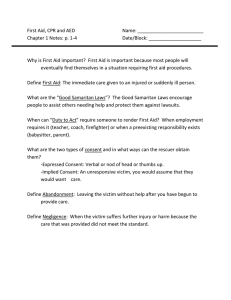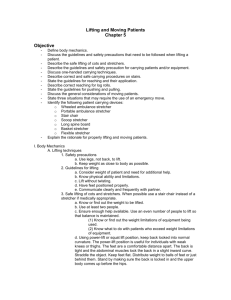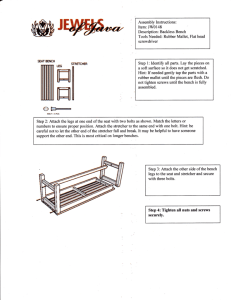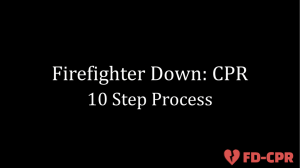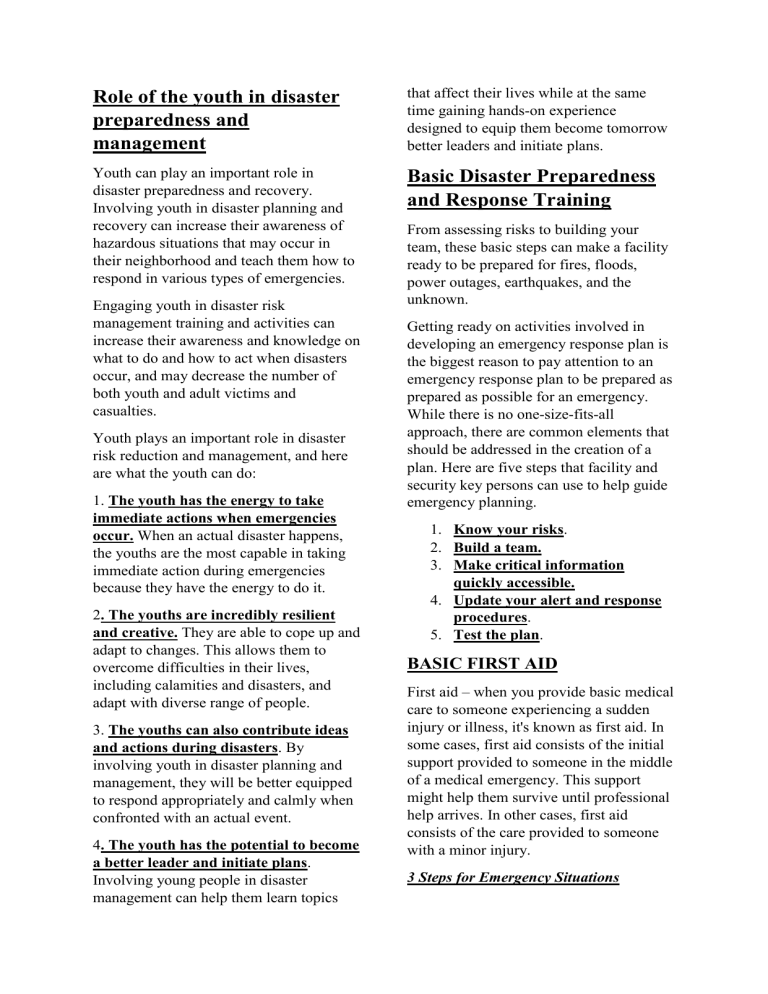
Role of the youth in disaster preparedness and management that affect their lives while at the same time gaining hands-on experience designed to equip them become tomorrow better leaders and initiate plans. Youth can play an important role in disaster preparedness and recovery. Involving youth in disaster planning and recovery can increase their awareness of hazardous situations that may occur in their neighborhood and teach them how to respond in various types of emergencies. Basic Disaster Preparedness and Response Training Engaging youth in disaster risk management training and activities can increase their awareness and knowledge on what to do and how to act when disasters occur, and may decrease the number of both youth and adult victims and casualties. Youth plays an important role in disaster risk reduction and management, and here are what the youth can do: 1. The youth has the energy to take immediate actions when emergencies occur. When an actual disaster happens, the youths are the most capable in taking immediate action during emergencies because they have the energy to do it. 2. The youths are incredibly resilient and creative. They are able to cope up and adapt to changes. This allows them to overcome difficulties in their lives, including calamities and disasters, and adapt with diverse range of people. 3. The youths can also contribute ideas and actions during disasters. By involving youth in disaster planning and management, they will be better equipped to respond appropriately and calmly when confronted with an actual event. 4. The youth has the potential to become a better leader and initiate plans. Involving young people in disaster management can help them learn topics From assessing risks to building your team, these basic steps can make a facility ready to be prepared for fires, floods, power outages, earthquakes, and the unknown. Getting ready on activities involved in developing an emergency response plan is the biggest reason to pay attention to an emergency response plan to be prepared as prepared as possible for an emergency. While there is no one-size-fits-all approach, there are common elements that should be addressed in the creation of a plan. Here are five steps that facility and security key persons can use to help guide emergency planning. 1. Know your risks. 2. Build a team. 3. Make critical information quickly accessible. 4. Update your alert and response procedures. 5. Test the plan. BASIC FIRST AID First aid – when you provide basic medical care to someone experiencing a sudden injury or illness, it's known as first aid. In some cases, first aid consists of the initial support provided to someone in the middle of a medical emergency. This support might help them survive until professional help arrives. In other cases, first aid consists of the care provided to someone with a minor injury. 3 Steps for Emergency Situations If you encounter an emergency situation, follow these three basic steps: 1. Check the scene for danger. Look for anything that might be dangerous, like signs of fire, falling debris, or violent people. If your safety is at risk, remove yourself from the area and call for help. If the scene is safe, assess the condition of the sick or injured person. Don't move them unless you must do so to protect them from danger. 2. Call for medical help, if needed. If you suspect the sick or injured person needs emergency medical care, tell a nearby person to call the local number for emergency medical services. If you're alone, make the call yourself. 3. Provide care. If you can do so safely, remain with the sick or injured person until professional help arrives. Cover them with a warm blanket, comfort them, and try to keep them calm. If you have basic first aid skills, try to treat any potentially life-threatening injuries they have. Remove yourself from danger if at any point in the situation you think your safety might be at risk. First Aid Bandage In many cases, you can use an adhesive bandage to cover minor cuts, scrapes, or burns. To cover and protect larger wounds, you might need to apply a clean gauze pad or roller bandage. To apply a roller bandage to a wound, follow these steps: 1. Hold the injured area steady. 2. Gently but firmly wrap the bandage around the injured limb or body part, covering the wound. 3. Fasten the bandage with sticky tape or safety pins. 4. The bandage should be wrapped firmly enough to stay put, but not so tightly that it cuts off blood flow. 1. First aid for burns: If you suspect that someone has a third-degree burn, call for help, dial the number of the nearest hospital. Seek professional medical care for any burns that: a. cover a large area of skin are located on the person's face, groin, buttocks, hands, or feet b. have been caused by contact with chemicals or electricity To treat a minor burn, run cool water over the affected area for up to 15 minutes. If that's not possible, apply a cool compress to the area instead. Avoid applying ice to burned tissue. It can cause more damage. Over-the-counter pain relievers can help relieve pain. Applying an aloe vera gel or cream can also reduce discomfort from minor burns. To help prevent infection, apply an antibiotic ointment and loosely cover the burn with clean gauze. Find out when you should contact a doctor for follow-up care. 2. First aid CPR: If you see someone collapse or find someone unconscious, call the local number of the nearest hospital. If the area around the unconscious person seems safe, approach them and begin CPR. Even if you don't have formal training, you can use hands-only CPR to help keep someone alive until professional help arrives. Here's how to treat an adult with hands-only CPR: a. Place both hands on the center of their chest, with one hand on top of the other. b. Press straight down to compress their chest repeatedly, at a rate of about 100 to 120 compressions per minute. c. Continue performing chest compressions until professional help arrives. 3. First aid for nosebleed: To treat someone with a nosebleed, ask them to: Sit down and lean their head forward Using the thumb and index finger, firmly press or pinch the nostrils closed. Continue to apply this pressure continuously for five minutes. Check and repeat until the bleeding stops. If the nosebleed continues for 20 minutes or longer, seek emergency medical care. The person should also receive follow-up care if an injury caused the nosebleed. 4. First aid for heatstroke: When your body overheats, it can cause heat exhaustion. If left untreated, heat exhaustion can lead to heatstroke. This is a potentially lifethreatening condition and medical emergency. If someone is overheated, encourage them to rest in a cool location. Remove excess layers of clothing and try to cool their body down by doing the following: a. Cover them with a cool, damp sheet. b. Apply a cool, wet towel to the back of their neck. c. Sponge them with cool water. Seek emergency medical care if they develop signs or symptoms of heatstroke, including any of the following: nausea or vomiting mental confusion fainting seizures a fever of 104°F (40°C) or greater If they're not vomiting or unconscious, encourage them to sip cool water or a sports drink. Take a moment now to learn about other strategies to help someone with heat exhaustion or heatstroke recover. 5. First aid for heart attack: If you think someone might be experiencing a heart attack, call the number of the nearest hospital. If they've been prescribed nitroglycerin, help them locate and take this medication. Cover them with a blanket and comfort them until professional help arrives. If they have difficulty breathing, loosen any clothing around their chest and neck. Start CPR if they lose consciousness. - First Aid Kit List You never know when you might need to provide basic first aid. To prepare for the unpredictable, consider storing a wellstocked first aid kit in your home. You can buy preassembled first aid kits from many first aid organizations, pharmacies, or outdoor recreation stores. Alternatively, you can create your own first aid kit using products purchased from a pharmacy. A standard first aid kit should include: 1. Adhesive Bandages (Plasters) 2. Sterile Gauze Pads 3. Adhesive Tape 4. Tweezers 5. Scissors 6. Disposable Gloves 7. Antiseptic Wipes or Solution 8. Pain Relievers 9. Thermometer 10. CPR Face Shield / Pocket Mask Lifting & Moving Patients Moving Victims: - - Moving injured victim will likely cause further injury In most cases wait for professional help May have to move a victim to protect them from danger at a scene May have to move a victim to a flat surface to provide CPR Body Mechanics: - Back injury is a hazard for First Responders To minimize Risks, use good body mechanics Body mechanics are the principles of using your body safely o Know your physical ability and limitations o Plan the lift o Ensure you have a good grip o Test the load o Position your feet properly before starting lift o Lift with your legs, not with your back o Keep patient’s weight close to your body o Avoid twisting your back during the lift o Communicate clearly with your partner and other EMS providers o Reposition a patient only when necessary o Reposition a breathing, unresponsive, non- trauma patient in the recovery position o Don’t move or reposition a trauma patient unless necessary to treat lifethreatening condition o Allow responsive patient to assume comfortable position Recovery Positions: 1. a. Helps keep airway open b. Allows fluid to drain from mouth c. Prevents aspiration d. If possible, put victim onto left side e. Continue to monitor breathing 2. For Unresponsive Breathing Infant a. Hold infant facedown over your arm with head slightly lower than body b. Support the head and neck with your hand, and keep nose and mouth clear 3. Modified HAINES a. Extend victim’s arm farther from you above victim’s head b. Position victim’s other arm across chest flexed knee and lifting with forearm while hand stabilizes head and neck. f. Continue to support head and neck position victim’s hand palm down. g. Check airway and open mouth to allow drainage Moving victims c. Bend victims nearer leg at knee d. Put forearm nearer victim’s head under victim’s nearer shoulder with hand under hollow of neck. e. Roll victim away from you by pushing on victim’s 1. Log Roll a. Use log roll to move patient from prone to supine b. Three to five rescuers are needed to safely roll patient c. For trauma patient with spinal injury, stabilize head in line with body d. The rescuer at the patient’s head holds the head in line with the body as two or three additional rescuers take position with hands at the patient’s lower and upper leg, hip and torso, and shoulder e. At the direction of the responder at the head, the rescuers in unison roll the patient toward them, with the head held in line and the spine straight f. The rescuers complete the log roll, positioning the patient on the back with head and neck still in line with the body 2. Emergency Moves a. Use only if i. patient faces an immediate danger ii. You cannot give lifesaving care because of location or position b. Risk of spinal injury i. Moving patient quickly risks aggravating a spinal injury ii. Keep head & neck in line with spine iii. It is impossible to protect spine while removing patient from a vehicle quickly c. Extrication from Vehicles i. First Responders may be trained in rapid extrication using cervical collar and inline stabilization of head/neck ii. Follow local protocol iii. Wait for EMTs trained in special extrication techniques d. One-Rescuer Emergency Drags i. Pull/drag patient in direction of long axis of body ii. Don’t drag patient sideways, and avoid twisting neck/trunk iii. Never pull head away from neck/shoulders iv. Risk of spinal injury can be minimized by using a blanket, rug, board, etc. v. Choice of move depends on materials at hand, patient’s condition, and situation 1. Clothing Drag 2. Blanket Drag 3. Shoulder Drag 4. Firefighter’s Drag 5. Upper Extremity Drag 6. Upper Extremity Drag for rapid extrication e. Emergency Carries i. Used when patient must be moved immediately ii. One or more rescuers may carry patient Method used depends on patient's size, condition and situation: 1. Walking assist 2. Cradle carry 3. Multiplerescuer techniques are safer /less stressful iii. Use good body mechanics/lifting techniques iv. Don’t try to lift/ carry person before checking their injuries 3. if Alone a. Pack strap carry i. Unresponsive victim who cannot safely be dragged b. Piggyback carry i. Lighter victim or child ii. Responsive victim iii. Support the patient’s weight with your arms under the patient’s thighs iv. If able, have the patient clasp hands and lean forward; if not able, grasp the patient’s hands with yours to keep patient from falling back c. Cradle carry i. Lighter victim or child ii. Responsive/ Unresponsive victims d. Firefighter’s carry i. Support the patient’s weight on your shoulders while holding the patient’s thigh and arm e. One-Person Walking assist i. Responsive victim who can walk with help 4. With Help a. Responsive victim: i. Two-Person Walking assist ii. Two-handed seat carry b. Two-Rescuer Extremity Carry i. To carry a patient down steps, the forward rescuer grasps patient's legs under the knees while the rear rescuer reaches under patient's armpits from behind to grasp the patient's forearms c. Two-Rescuer Assist i. Both rescuers position the patient's arms over their shoulders ii. Each rescuer grasps the patient's wrist, with the other arm around the patient's waist 5. Non-Emergency Moves a. Used to move patient when no threat to life b. Performed by multiple rescuers c. Not used if patient has suspected spinal injury, internal bleeding, or uncontrolled external bleeding d. Stabilize patients before moving them e. Minimize any chance of aggravating illness or injury f. These moves are usually performed by responding EMS personnel g. Before Using a NonEmergency Move i. Complete primary/secondary assessment ii. Correct any lifethreatening problems iii. Immobilize all suspected fractures/ dislocations iv. Ensure there are no signs/symptoms of neck/ spinal injury 6. Direct Ground Lift a. Non-emergency moves for patients without suspected neck or spinal injuries b. Used to lift/carry supine patient from ground to stretcher c. Rescuers kneel on one side of the patient d. Rescuer at head places one arm under the patient's neck and shoulder and cradles the patient's head e. Rescuers lift patient to their knees and roll the patient in toward their chests f. Rescuers stand and move patient to stretcher 7. Extremity Lift a. Two-rescuer technique used for patients without suspected injury to neck, spine, or extremities b. May be used with responsive/unresponsive patient c. May be used to carry patient a short distance or move patient from chair to stretcher d. May be used to carry a patient through a tight space e. The first rescuer kneels at the patient's head and the second rescuer kneels by the patient's feet. The rescuer at the head places one arm under each of the patient's shoulders while the rescuer at the feet positions the patient's arms. f. The rescuer at the head then slips his or her hands under the patient's armpits and grasps the patient's wrists and crosses them on the patient’s chest. The rescuer at the feet turns around and reaches his or her hands back and under the patient's knees. g. Both rescuers move to a crouching position and assess their grip on the patient h. On a signal from the rescuer at the head, the rescuers stand up simultaneously and move forward with the patient 8. Extremity Lift – Alternative Position a. Preferred if rescuers must move some distance or over inclined surface b. Rescuer at patient’s feet may face patient and other rescuer c. Can be used to move patient to side or short distance d. Transfer from Bed to Stretcher e. Assist EMS personnel transferring patient from bed to stretcher f. Use either direct carry or draw sheet technique g. Not used with patient with suspected spinal injury 9. Direct Carry a. Position the stretcher at a right angle to the bed, ideally, with the head end of the stretcher at the foot of the bed. The stretcher should be at the same height as the bed. Unbuckle the straps and remove other items from the stretcher. Both rescuers stand between the bed and the stretcher, facing the patient. b. The rescuer at the head slides one arm under the patient's neck and cups the patient's farther shoulder. The second rescuer slides one arm under the patient’s hips and lifts slightly. The rescuer at the head slides his or her other arm under the patient's back, and the second rescuer places his or her other arm underneath the patient’s thighs near the knees. Together, both rescuers slide the patient to the edge of the bed. c. On a signal of the rescuer at the head, the rescuers lift and curl the patient toward their chests d. The rescuers step back, rotate towards the stretcher, and place the patient gently on the stretcher 10. Draw Sheet Transfer a. Loosen bottom bed sheet and roll its edge on the side where you will place stretcher b. Position stretcher alongside bed. c. Prepare stretcher: i. Adjust height, lower rails, and unbuckle straps ii. Both responders reach across stretcher and grasp rolled sheet edge firmly at level of patient's head, chest, hips, and knees d. Slide patient gently onto stretcher 11. Draw Sheet Transfer – Alternative Method a. Rescuers first roll patient onto one side, and one rescuer holds the patient in that position. Second rescuer positions a sheet with rolled edge beneath patient b. The patient is rolled back into original position, now on the sheet c. The rescuers together pull on sheet to slide patient onto stretcher EMS Equipment for Moving Patients - - First Responders often assist EMTs with packaging and moving patients A wide range of commercial devices are used - Learn devices you are likely to encounter in your area Typical Equipment for Packaging and Moving Patients - Long Backboard Short Backboard Vest Extrication Device Standard Stretcher Portable Stretcher Orthopedic Stretcher Basket Stretcher Stair Chair
